Serene Geumsunsa Temple
of Bukhansan Mountain
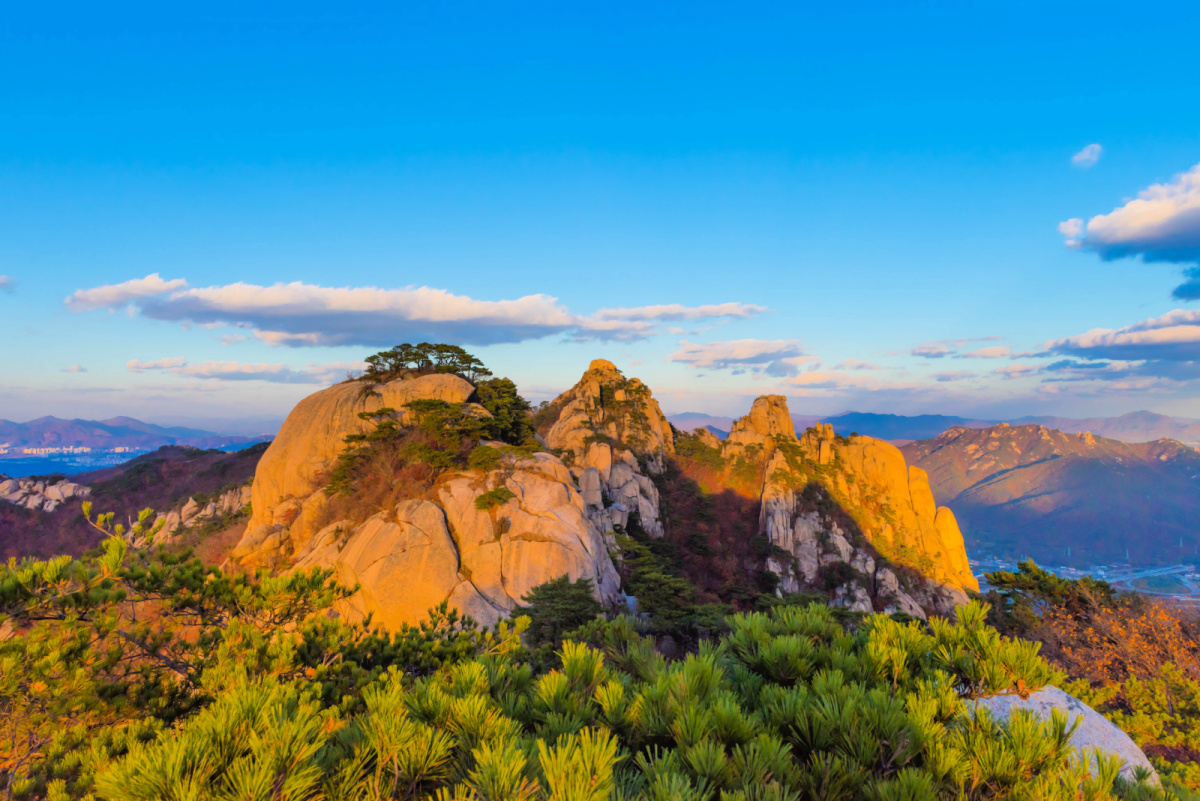 Geumsunsa Temple of Bukhansan nestles near one or two of the national park's scenic rock formations and peaks.
Geumsunsa Temple of Bukhansan nestles near one or two of the national park's scenic rock formations and peaks.Geumsunsa Temple of Bukhansan
Geumsunsa Temple is a renowned Buddhist temple in Bukhansan Mountain, a popular hiking destination among locals and tourists.
The temple is known for its serene atmosphere and beautiful architecture that dates back to the Joseon dynasty.
Visitors can enjoy a peaceful retreat from the hustle and bustle of city life and explore the surrounding natural beauty of Bukhansan Mountain.
Geumseonsa Temple of Bukhansan, also spelled as Geumsunsa Temple, is a 600-year-old temple situated in Mt. Bukhansan National Park in Seoul.
Historically, it was where King Jeungjo of Joseon (r. 1776-1800) prayed for the birth of a male heir. The temple is known for its specialization in Seon meditation.
The temple grounds are surrounded by natural beauty and feature a beautiful stream under the Hongyae-go Bridge (Nirvana Bridge). The temple offers two different Templestay programs.

Templestay Programs
The Relaxational Templestay program includes meditation, temple touring, and Buddhist ceremonies. On the other hand, the 2022 Daily Templestay program focuses on tea making, meditation, and bead making.
This location is renowned for its tranquil ambiance and stunning architecture and is a well-known spot for hiking enthusiasts.
Nestled amidst breathtaking natural surroundings, this destination has a reputation for offering visitors a serene and peaceful atmosphere.
The picturesque architecture of the place adds to its charm, making it a must-visit spot for those who admire scenic beauty.
Moreover, it is a popular destination for hiking enthusiasts who love to explore the area's natural wilderness.
Geumsunsa is situated in Gukidong, Jongno-gu, facing Mt. Inwangsan and close to the Blue House and Gyeongbokgung Palace. It is only a 30-minute drive from Gwanghwamun Square.
The temple is located in the center of Seoul, yet it offers a serene and natural environment.
The mountain stream that flows from Bibong Peak and Hyangrobong Peak in the Mt. Bukhansan National Park passes under Hongyaekyo Bridge of Nirvana at the temple. This gives visitors a glimpse of the temple's natural beauty.
History & Architecture
Geumsunsa Temple of Bukhansan in Seoul, established during the Joseon Dynasty, is a significant site of Korean Buddhist heritage.
It is renowned for its traditional architectural style, embodying the era's distinctive aesthetics and spiritual philosophy.
The temple's main hall, bell pavilion, and stone lanterns showcase exquisite craftsmanship and serene beauty.
These elements highlight the temple's historical importance and its role as a center for meditation and Buddhist practice amidst the tranquil surroundings of Mt. Bukhansan.
Temple Activities
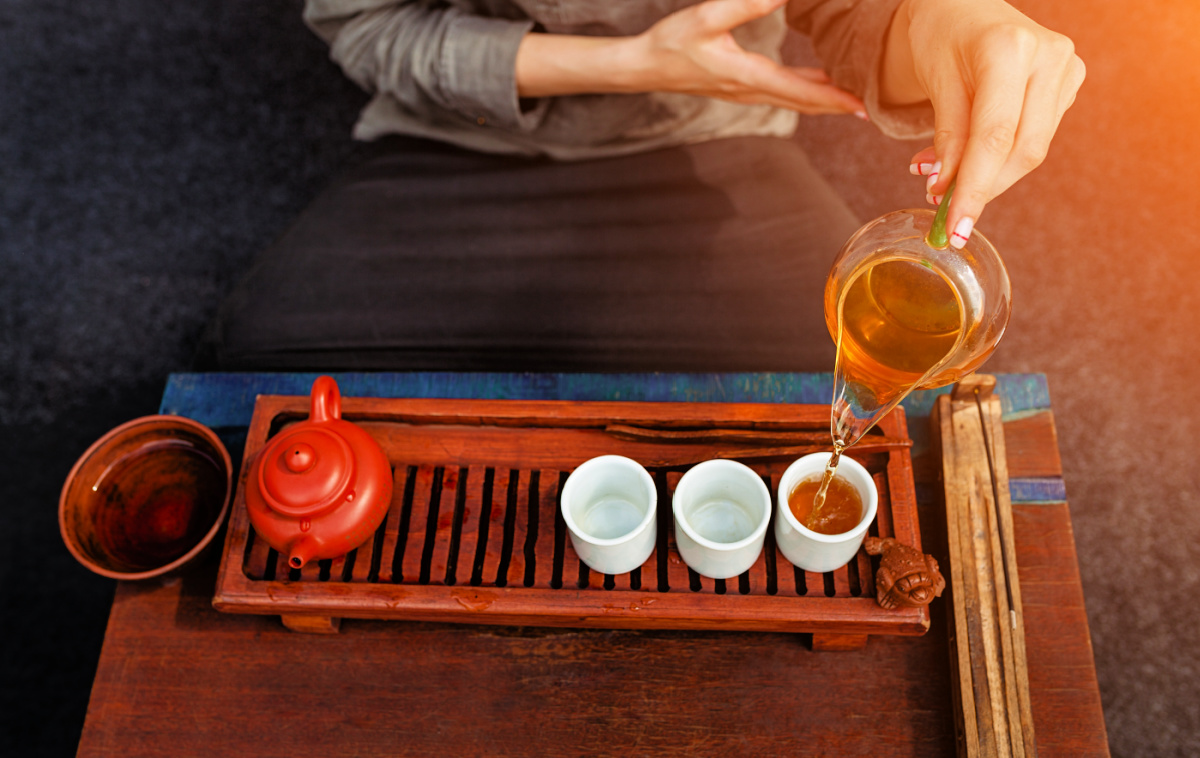 A tea ceremony is a meditative and mindfulness practice in Buddhism.
A tea ceremony is a meditative and mindfulness practice in Buddhism.If you are seeking for a release from your daily hassles, you can find serenity and focus at Geumsunsa Temple of Bukhansan Mountain. What you can do is join at their regular meditation sessions, and other meditative activities and practices.
The following text describes three Buddhist practices: 108 Prostrations, Cham-Seom (Sean Meditation), and Da-Seon (Tea Ceremony).
108 Prostrations is a Buddhist practice involving bowing to take refuge in The Three Jewels (Buddha, the Dharma, and the Sanga), showing respect for others, and humility. The number 108 represents worldly sufferings, and each bow purifies one defilement.
Cham-Seom (Sean Meditation) is a Korean Buddhist meditation technique that aims to cut off all thoughts. By practicing mindfulness and concentration, you can learn to quiet your mind.
Da-Seon (Tea Ceremony) is a meditation practice that involves mindfulness through brewing and drinking tea. Drinking tea engages all five senses at once:
- Your eyes see the color of the tea.
- Your ears hear the sound of the water.
- Your nose smells the fragrance.
- Your tongue tastes the flavor.
- Your hands feel the warmth of the cup.
This is why it is sometimes called Da-Seon-il-mil.
Bukhansan Mountain and the Hiking Trails
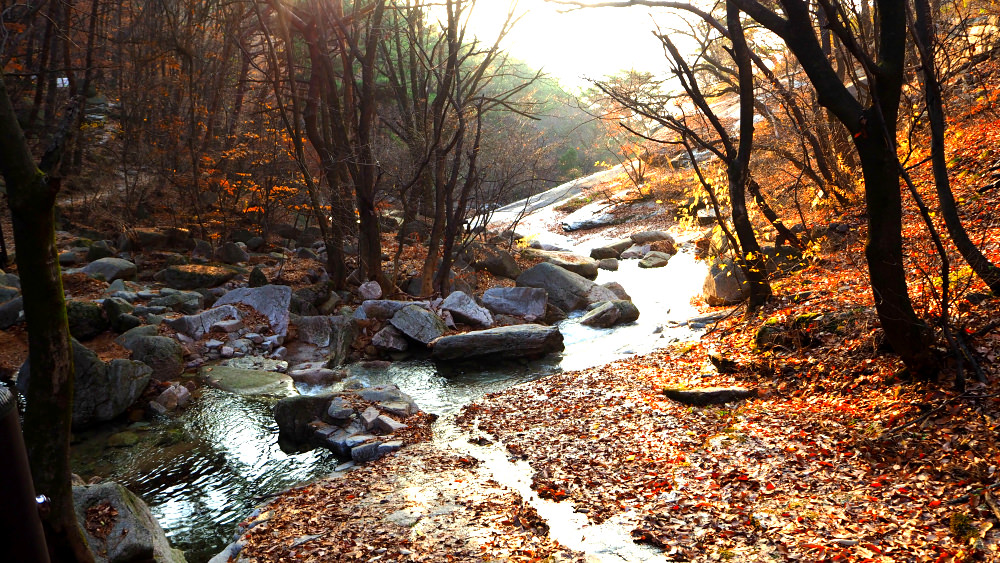
Bukhansan Mountain, nestled in the heart of Korea, is a true marvel of nature that never fails to leave visitors in awe.
The majestic mountain range extends towards the North, offering breathtaking views of the surrounding landscape.
During the Spring, delicate cherry blossoms adorn the trails, providing a stunning display of colors and fragrances.
In the Autumn, the mountain is ablaze with a vibrant array of hues as the leaves turn golden, orange, and red.
As you approach the temple area, you'll find yourself surrounded by an abundance of natural beauty that's impossible to ignore.
The hiking trails that lead to the temple are a nature lover's paradise, with crystal-clear streams, lush green foliage, and a diverse range of flora and fauna.
Once you reach Geumsunsa Temple, you can take a moment to appreciate the serenity of your surroundings. The meditation room is ideal for reflection and finding inner peace, but you need not limit yourself to it.
With its tranquil ambiance, the garden area is perfect for quiet contemplation, and the rocky outcrops offer an unforgettable panoramic view of the mountain range.
Monk's Meal
At Buddhist temples, the daily food is called the "Monk's Meal." This meal is an integral part of the practice, and the food preparation is just as important as eating it. The monks and nuns within the temple work together to grow and harvest the vegetables used in the meal.
The food served at the temple is entirely natural and free from any artificial ingredients or preservatives.
In keeping with the Buddhist philosophy of non-violence, the food is completely vegetarian, except for dairy products. This means no animal products, such as meat or fish, are used in food preparation.
The Monk's Meal provides nourishing and wholesome food that supports physical and mental health. The meal is primarily vegetable-based, and so it is rich in essential vitamins and minerals.
This simple yet nutritious food is an integral part of the daily routine for those living in the temple. It reflects the mindful and compassionate approach to living at the heart of Buddhist practice.
Cultural Significance
Geumsunsa Temple is a profoundly significant cultural landmark in Korea, renowned for its pivotal role in promoting the teachings of Buddhism throughout the region.
The temple is nestled amidst the tranquil natural beauty of the Baekdudaegan mountain range, offering visitors a serene and awe-inspiring setting for spiritual reflection and contemplation.
Its rich history spans over 600 years, and it has been a pilgrimage site for countless devotees seeking enlightenment and inner peace.
Geumsunsa Temple is a testament to the enduring legacy of Buddhism in Korea and a cherished symbol of the country's cultural and spiritual heritage.
Lanterns on Buddha's Birthday
Geumsunsa Temple, located in the heart of Seoul, South Korea, is known for its vibrant and lively exhibition of radiant lanterns.
Every year, the temple celebrates the birth anniversary of Buddha by displaying these colorful lanterns both inside and outside the temple. The lanterns are intricately designed and crafted, creating an awe-inspiring ambiance that attracts visitors worldwide.
The exhibition is a sight, with the lanterns illuminating the temple grounds and casting a warm and welcoming glow.
It's a beautiful and unique way to celebrate Buddha's birthday, which shouldn't be missed if you're ever in Seoul during this time of the year.
Getting to Geumsunsa Temple in Bukhansan
By Bus and Subway
- Start at Gyeongbokgung (경복궁) Station.
- Exit from (Exit 3) and walk straight for about 70 meters to the bus stop (경복궁역).
- Take the Green bus (No.7212) and get off at Yibukodochung (이북오도청).
- Walk North (toward the mountain) for approximately 20 minutes on the main roads. You will come across several 'Guemsunsa Temple' signs from the bus stop.
- Once you reach the entrance of the mountain, hike up about 500 meters. When you see a restroom on your right at the crossroad, turn LEFT towards Guemsunsa Temple (금선사).
By Taxi
Tell the driver to drop you off at Geumsunsa (금선사). If the driver doesn't know, then tell them the direction to Yibuk-odochung (이북오도청).
If the driver is unfamiliar with the roads, please show this address: Geumsunsa Address (금선사 주소): 서울 종로구 비봉길 137 금선사
Contact : +82-10-2685-9913
- Open from 09:00~17:00
- If you have any questions, please contact below: Geumsunsa Templestay +82-10-2685-9913 (whatsapp, kakaotalk) / geumsunsa@templestay.com
Templestay Website: https://world.seoul.go.kr/service/amusement/temple-stay/
Enjoy your travels!
- Home
- Temples in South Korea
- Geumsunsa Temple of Bukhansan
Get Exciting Activities
Book one of our exciting activities today to experience the thrill of a lifetime! Take advantage of this opportunity and secure your spot in advance.
Hotel Map Guide
Find your affordable, accessible, and comfortable hotel in Seoul at Agoda.Com. See the hotel map below...
Hotel Booking Guide
Find affordable and amazing hotels on Agoda.com using the search box below. Book now to enjoy great discounts and save!
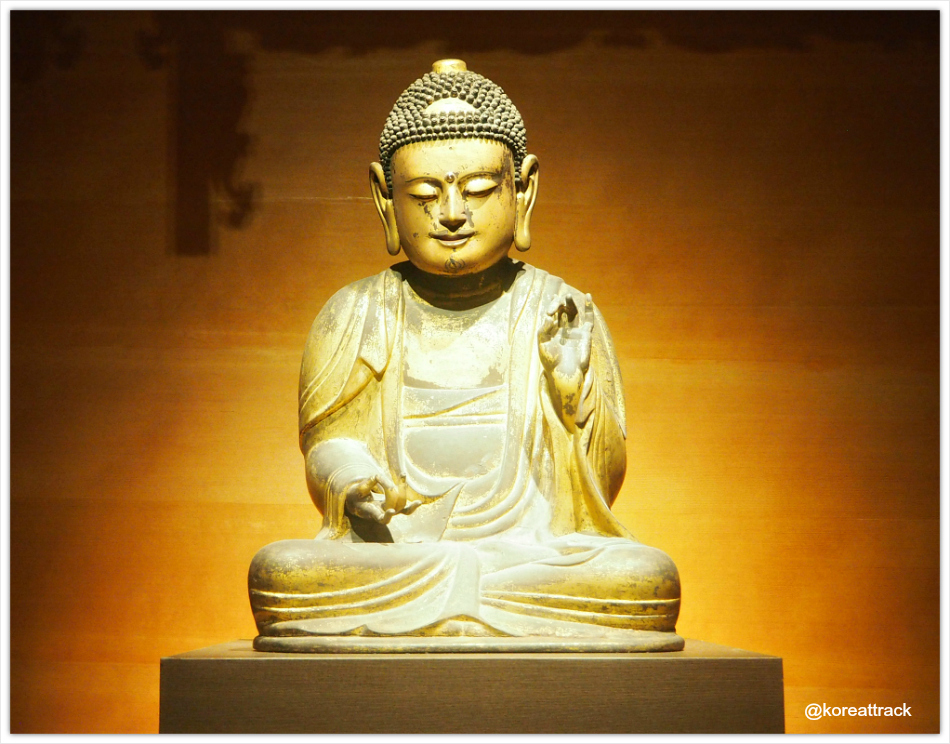
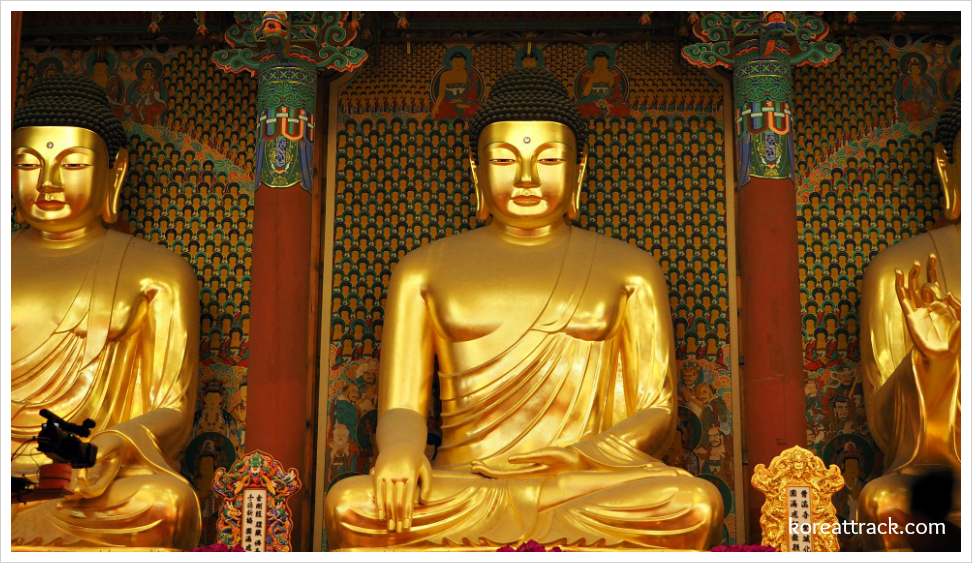
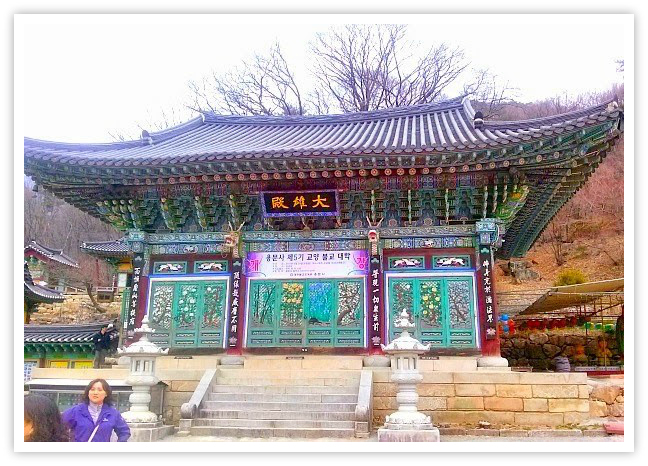




New! Comments
What do you think about this page? Leave me a comment in the box below.